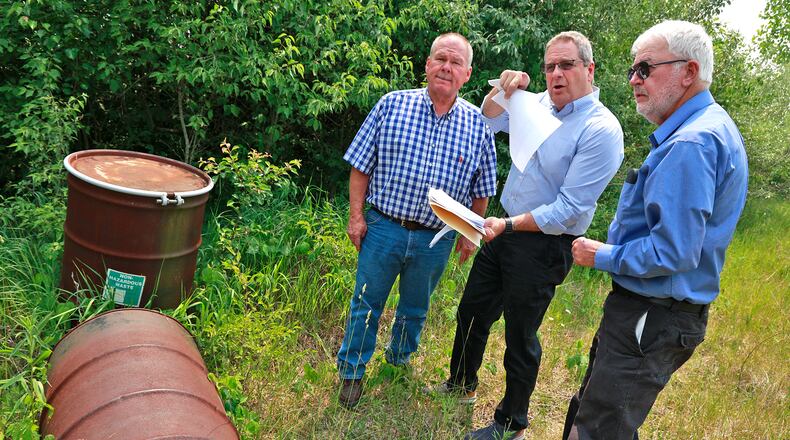The 8.5-acre Tremont City Barrel Fill site located in German Twp. is a closed industrial waste landfill. During operations from 1976 to 1979, it’s estimated about 51,500 drums and 300,000 gallons of industrial waste were disposed of at the site, which threatens a nearby aquifer that provides drinking water to tens of thousands of area residents.
The site contains an estimated 1.5 million gallons of hazardous waste buried in the ground. This waste includes glues, resins, paint sludge, paint scraps, soap, shampoo, detergent, asbestos, oils and other industrial compounds. Food industry sources also disposed of items such as margarine and corn syrup.
The disposal stopped in 1980, and soil was later placed on top of the waste cells. Seventeen years later, the U.S. EPA began an investigation into the barrel fill and found some leaks from waste cells. An investigation by the potentially responsible parties in 2005 found most of the waste cells were intact, but showed high levels of contaminants at the barrel fill site.
Contaminants include elevated levels of volatile organic compounds, such as xylenes, ethylbenzene, toluene and methylene chloride. Metals such as chromium and arsenic were also detected in the liquid and solid waste.
Jenny Polster, the EPA remedial project manager for the site, said during city and county commission meetings that the top of the barrels are believed to be buried about 10 to 17 feet deep.
Bob Rule, a representative for the potentially responsible parties, said during the city commission meeting that workers will bore into the ground in several areas to find out exactly where the barrels are to avoid digging into them and to evaluate the soil to see how it can be reused.
Residents have fought for years to get the site cleaned up. The concern was that toxic waste may have seeped into the Buried Valley Aquifer and could impact local drinking water or continue to seep into the ground if not addressed. Those concerns led to the formation of the group People for Safe Water.
In October, the U.S. District Court for the Southern District of Ohio approved the cleanup plan after it granted the motion to approve a consent decree signed in April 2022 by all parties to begin the process of cleaning up the landfill.
In the court order, all responsible companies said they acknowledged they have waste in the landfill and are responsible for the chemicals. They entered into the federal agreement — a Superfund Alternative Approach Agreement — and signed the decree that they will clean it up and shoulder some of the financial burden to do so.
Rule said the information learned in the first five to six weeks at the site will “steer the design work,” with workers figuring out what they need to build, how best to pull the barrels out and more. He said one of the first steps will be evaluating utilities in the area in the area to make sure workers don’t dig up or drill through phone lines or anything like that.
The actual cleanup of the site will not start until the predesign process is completed in a few years, Polster said. Waste will be excavated, characterized and disposed of properly.
She said the predesign process may be completed by 2025 or 2026, but there is no way of knowing for sure until the site is completely evaluated.
“I can promise you we’re not just sitting at our desks not doing anything; I mean we really are spending the time to make sure this is done right,” Polster said at the regular county commission meeting Wednesday.
Rule said at the site, workers will analyze existing water quality monitoring wells for efficacy, and stop use of ones that are damaged or have been open to the elements. New wells will be built as needed and the potentially responsible parties, with the oversight of the EPA, will monitor the area’s water quality in perpetuity.
“I commit to making sure that we have resources available to make sure that there’s a confident well monitoring network in place,” Polster told the community.
City Commissioner David Estrop said during the Tuesday meeting he is excited to see steps toward the cleanup being taken.
Larry Ricketts, of People for Safe Water, a citizens group that has pushed for decades for the cleanup project, said during the city meeting he is glad to see the communication between the EPA and the community improving.
“Just in the last couple of years since you’ve been on board, (communication) is so much better than what we’ve had in the past,” Ricketts told Polster.
One of her roles on the project is to repair the relationship between the EPA and the community, Polster said.
“From this point forward you are going to start to hear from us very regularly,” Polster said.
The EPA will post monthly updates and other information regarding the project on its website.
About the Author

